 What Is A Scone?
What Is A Scone?
When you hear the word “scone” do you think of a fancy British tea-time spread? Or do you think of the sugar-dusted pastries in the Starbucks display case that you might be tempted to grab to go along with your morning coffee?
Authentic British scones aren’t eaten for breakfast. Rather, they are served with tea as a light snack for “cream tea” in the mid-morning or with afternoon tea. (Not to be confused with “high tea,” which includes more savory nibbles.)
British scones are small nibbles that are fairly plain on their own but are classically eaten with jam and clotted cream, making for a real treat.
Is A Scone A Biscuit?
When you first try an authentic British scone, you might be tempted to think of it as a biscuit. (Unless, of course, you’re from the southern US, where biscuit-making is an art. No real scone would fool a Southerner as a biscuit, that’s for sure.)
But, you can’t deny that the two are similar.
The basic ingredients for biscuits and scones really are the same: flour, leavening, a little salt, some fat, milk, and maybe a little sugar. The process too is similar: cut the fat into the dry ingredients, add the liquid, roll, and bake.
The difference comes down to a subtly in texture and how they are served.
British scones are denser, slightly drier, and more crumbly than biscuits. They typically contain much less butter than biscuits as well.
While biscuits most likely originated from the British scone, they have been transformed and now are the scone’s buttery cousin. Because of the extra butter, biscuits should be light and fluffy with tender layers.
While scones are spread with jam and clotted cream (which you can make yourself as oven clotted cream or as slow cooker clotted cream), biscuits more commonly find themselves in savory applications, like with sausage gravy or an egg and bacon.
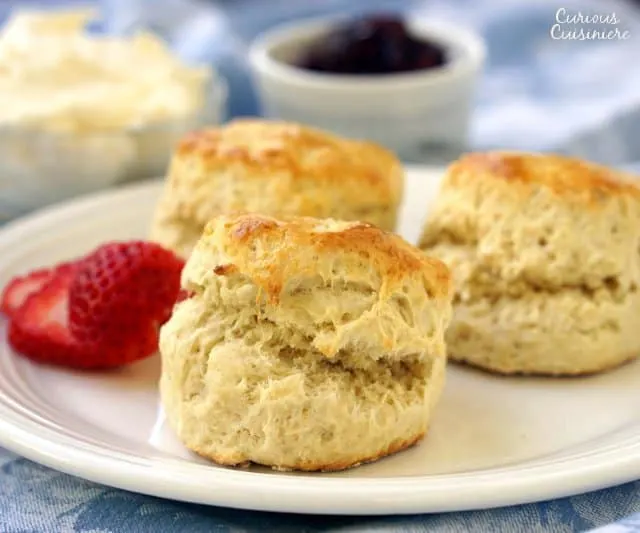 An American Scone vs A British Scone
An American Scone vs A British Scone
If you walk into a coffee shop in the States, you’re bound to come face to face with some tasty treat labeled “scone”. It will probably be sweet, most likely filled with any number of sweet add-ins, and possibly even covered with a sugary glaze.
It might be biscuit-like in texture or it might be cakier, depending on the establishment. And, it probably will be about the size of your hand.
By now you know better.
These are not traditional British scones! They’re too big, too sweet, and too stand-alone. Not to mention all the flavor add-ins that are unheard of when it comes to a traditional scone. (Which might get some raisins tossed into the batter, but that’s about as crazy as things get.)
Besides, when was the last time you ventured to put jam on your American scone? (As if it needed the extra sugar.)
How To Make British Scones
That being said, if you can make biscuits, then you can make scones.
Scone dough is made from simple ingredients that you probably keep your pantry stocked with. So, you can have a batch of scones turned out dangerously fast.
The one difference we take between making biscuits and making scones is that for scones, we use our hands to massage the butter into the dry ingredients. Doing this creates a fine, sandy consistency that helps give the scones their classic texture. (For biscuits we cut the butter into the dry ingredients, which leaves larger chunks of butter in-tact, creating those tasty, buttery layers.)
Whether you call it a biscuit or a scone, these tasty treats are great for breakfast or for an afternoon nibble.
Just don’t forget the jam and clotted cream!
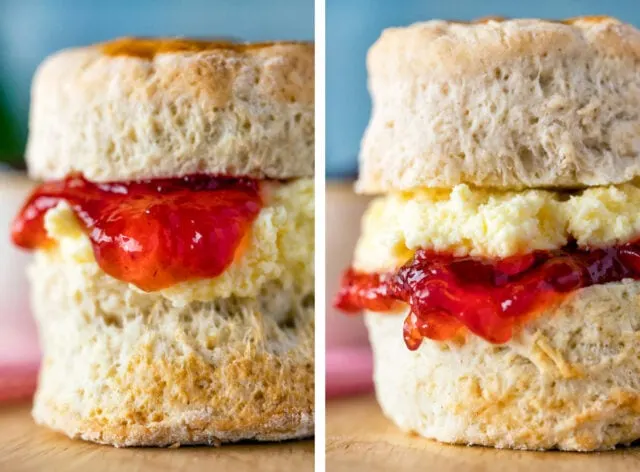
Which way do you take your scones?
Authentic British Scones
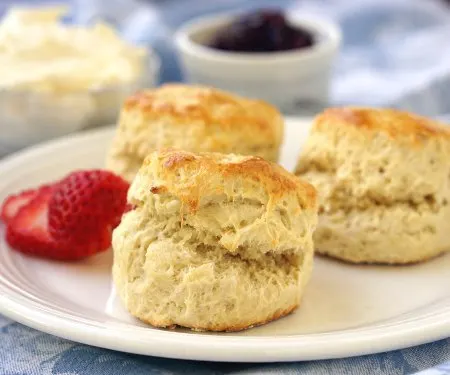
An authentic British Scone is the perfect accompaniment to your warming cup of tea, particularly if you have some clotted cream and jam to serve it with!
Ingredients
- 2 c unbleached all-purpose flour
- 2 Tbsp sugar
- 4 tsp baking powder
- ½ tsp salt
- 3 Tbsp unsalted butter, cold
- ⅔ c milk
- 1 egg yolk beaten with 1 Tbsp milk, (to glaze)
- Strawberry jam, (to serve)
- Clotted cream, at room temerature (to serve)
Instructions
- Preheat your oven to 425F.
- In a medium bowl, place the flour, sugar, baking powder, salt, and butter. Rub the mixture together with your fingers to break up the butter, until the mixture resembles fine breadcrumbs.
- Add the milk slowly, mixing as you add, using enough of the milk to get your dough to come together with no lumps remaining. (Your dough should be quite sticky. If a good consistency is not achieved with the listed amount of milk, continue adding until your dough reaches a good consistency.)
- Spoon the dough out until a well-floured surface. Generously dust the top of the dough and knead the dough 2-3 times to coat it with flour and smooth the surface. Press the dough into a round that is roughly 1 inch thick.
- Using a well-floured cookie cutter, cut the dough into 2 inch circles. (Be sure to press the cookie cutter straight down and up. Twisting the cookie cutter will impact the amount of rise you get on your scones.)
- Place the rounds onto a greased and floured baking sheet. Brush them gently with the egg yolk and milk mixture.
- Bake the scones for 12-15 minutes, until golden and firm.
- Remove the baked scones from the oven and let them cool for 30 minutes (if you can resist). If you like softer scones, cover them with a clean tea towel as they cool.
Notes
This scone batter freezes well. We like to freeze pre-cut rounds of dough for easy baking (just thaw and bake as directed).
Alternately, freeze the baked scones and reheat in a low oven for 5-10 minutes after thawing on the counter.
Want to convert to WEIGHT measurements? Have a look at our ingredient conversion guide.
Nutrition Information:
Yield:
10Serving Size:
1 sconeAmount Per Serving: Calories: 71
If you liked this recipe, here are some similar dishes you may enjoy!

Sarah is one of Curious Cuisiniere’s founding duo. Her love for cultural cuisines was instilled early by her French Canadian Grandmother. Her experience in the kitchen and in recipe development comes from years working in professional kitchens. She has traveled extensively and enjoys bringing the flavors of her travels back to create easy-to-make recipes.
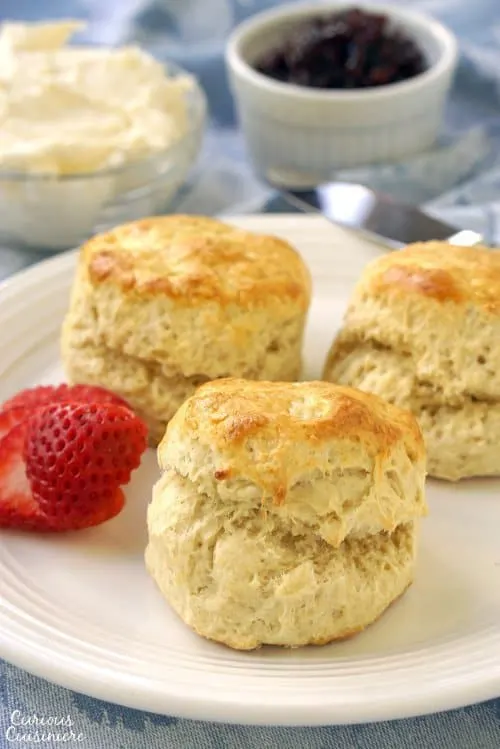 What Is A Scone?
What Is A Scone?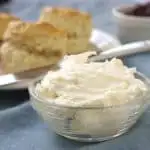


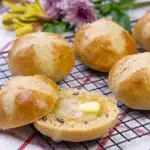
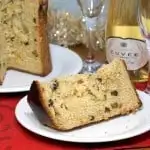
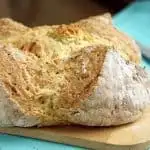
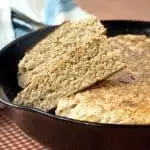

Steph
Monday 25th of March 2024
These scones turned out so well! I made the dough ahead of time and frozen it, defrosted in the fridge overnight and baked off at instructed. These will be my new go to!
Sarah - Curious Cuisiniere
Tuesday 26th of March 2024
We're so glad you enjoyed the scones Steph!
Teresa
Tuesday 13th of February 2024
These are great! I usually use whey instead of the milk for the liquid - I always have leftovers from making yogurt, but it's also a great way to use the whey from your clotted cream recipe (which is also awesome, by the way). Several comments about needing more liquid than the recipe calls for; this is pretty normal because flour can really vary in its moisture content depending on humidity.
Sarah - Curious Cuisiniere
Saturday 17th of February 2024
Thanks Teresa! Great idea to use the whey from the clotted cream!
David
Wednesday 24th of January 2024
I'm English, and will confirm that these are the genuine article! I double the recipe and get 15 scones out of it.
You can also just use parchment paper, no need to grease and flour the baking tray (or flour the cutter, really, but DON'T twist it when cutting).
But the real question is whether you do jam then cream, or cream then jam? ;)
Sarah - Curious Cuisiniere
Saturday 27th of January 2024
Thank you David! We like to switch it up, just to keep things interesting. ;)
Lisa
Tuesday 23rd of January 2024
Hi,
I'm hoping you can weigh in on whether or not to include an egg in the recipe for the dough (in addition to egg wash). I've seen a number of recipes that claim to be authentic and they include an egg. I had an old recipe for scones that had an egg and I used to make them this way, but later fI ound a recipe that did not call for an egg and I much prefer the non-egg recipe for it's texture. Do you know which is the more authentic version?
Thanks, Lisa
Sarah - Curious Cuisiniere
Saturday 27th of January 2024
Hi Lisa. The recipe we have here is based on our research. But many widely popular recipes, like this one, have many ways of making them. Home cooks adapt and share recipes. So, it is possible that using an egg may be authentic in some regions, while no egg may be authentic in others. Maybe some of our readers can weigh in on this!
Shahira Boctor
Wednesday 20th of December 2023
Hi Sarah, I’ve used this recipe so many times and I always get great results. Amazing taste, I also make a big batch of the clotted cream, divide them into small containers and freeze them. When I need the cream I get it out a day in advance. Wonderful recipe. Thank you very much
Sarah - Curious Cuisiniere
Monday 8th of January 2024
We're so glad you enjoy these scones! Thank you for sharing your tip on freezing the clotted cream. That is a great idea!